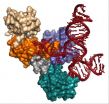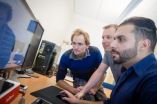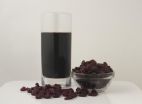(Press-News.org) MADISON, Wis. — A grandfather clock is, on its surface, a simple yet elegant machine. Tall and stately, its job is to steadily tick away the time. But a look inside reveals a much more intricate dance of parts, from precisely-fitted gears to cable-embraced pulleys and bobbing levers.
Like exploring the inner workings of a clock, a team of University of Wisconsin-Madison researchers is digging into the inner workings of the tiny cellular machines called spliceosomes, which help make all of the proteins our bodies need to function. In a recent study published in the journal Nature Structural and Molecular Biology, UW-Madison's David Brow, Samuel Butcher and colleagues have captured images of this machine, revealing details never seen before.
In their study, they reveal parts of the spliceosome — built from RNA and protein — at a greater resolution than has ever been achieved, gaining valuable insight into how the complex works and also how old its parts may be.
By better understanding the normal processes that make our cells tick, this information could some day act as a blueprint for when things go wrong. Cells are the basic units of all the tissues in our bodies, from our hearts to our brains to our skin and lungs.
It may also help other scientists studying similar cellular machinery and, moreover, it provides a glimpse back in evolutionary time, showing a closer link between proteins and RNA, DNA's older cousin, than was once believed.
"It gives us a much better idea of how RNA and proteins interact than ever before," says Brow, a UW-Madison professor of biomolecular chemistry.
The spliceosome is composed of six complexes that work together to edit the raw messages that come from genes, cutting out (hence, splicing) unneeded parts of the message. Ultimately, these messages are translated into proteins, which do the work of cells. The team created crystals of a part of the spliceosome called U6, made of RNA and two proteins, including one called Prp24.
Crystals are packed forms of a structure that allow scientists to capture three-dimensional images of the atoms and molecules within it. The crystals were so complete, and the resolution of the images so high, the scientists were able to see crucial details that otherwise would have been missed.
The team found that in U6, the Prp24 protein and RNA — like two partners holding hands — are intimately linked together in a type of molecular symbiosis. The structure yields clues about the relationship and the relative ages of RNA and proteins, once thought to be much wider apart on an evolutionary time scale.
"What's so cool is the degree of co-evolution of RNA and protein," Brow says. "It's obvious RNA and protein had to be pretty close friends already to evolve like this."
The images revealed that a part of Prp24 dives through a small loop in the U6 RNA, a finding that represents a major milestone on Brow and Butcher's quest to determine how U6's protein and RNA work together. It also confirms other findings Brow has made over the last two decades.
"No one has ever seen that before and the only way it can happen is for the RNA to open up, allow the protein to pass through, and then close again," says Butcher, a UW-Madison professor of biochemistry.
Ultimately, Butcher says they want to understand what the entire spliceosome looks like, how the machines get built in cells and how they work.
While this is the first protein-RNA link like this seen, Brow doesn't believe it is unique. Once more complete, high-resolution images are captured of other RNA-protein machines and their components, he thinks these connections will appear more commonly.
He hopes the findings mark a transition in the journey to understand these cellular workhorses.
"It's exciting studying these machines," he says. "There are only three big RNA machines. Ours evolved 2 billion years ago. But once it's figured out, it's done."
The U6 crystal structure was imaged using the U.S. Department of Energy Office of Science's Advanced Photon Source at Argonne National Laboratory. The work was funded by a joint grant from the National Institutes of Health shared by Brow and Butcher.
INFORMATION:
-- Kelly April Tyrrell, 608-262-9772 or ktyrrell2@wisc.edu
NOTE: An animation to accompany this release can be downloaded at http://bit.ly/SodaqN
Scientists capture most detailed images yet of humans' tiny cellular machines
2014-06-02
ELSE PRESS RELEASES FROM THIS DATE:
Computer scientists develop tool to make the Internet of Things safer
2014-06-02
Computer scientists at the University of California, San Diego, have developed a tool that allows hardware designers and system builders to test security- a first for the field. One of the tool's potential uses is described in the May-June issue of IEEE Micro magazine.
"The stakes in hardware security are high", said Ryan Kastner, a professor of computer science at the Jacobs School of Engineering at UC San Diego.
There is a big push to create the so-called Internet of Things, where all devices are connected and communicate with one another. As a result, embedded ...
NASA's TRMM satellite sees Eastern Pacific tropical cyclone forming
2014-06-02
VIDEO:
This 3-D animated fly-by of developing tropical low pressure System 93E on June 2 revealed the highest thunderstorms (in red) as it continues to develop.
Click here for more information.
There's a new tropical low pressure area brewing in the Eastern Pacific and NASA's TRMM satellite flew overhead and got a read on its rainfall rates and cloud heights.
The eastern Pacific Ocean has become active on cue with the start of the hurricane season in that area. Only a few days ...
Laser device can detect alcohol in cars, say authors in Journal of Applied Remote Sensing
2014-06-02
BELLINGHAM, Washington, USA — A new open-access article in the Journal of Applied Remote Sensing is garnering attention for research that could aid in the campaign to prevent drunk driving: a device that can detect alcohol in cars. The Journal of Applied Remote Sensing is published by SPIE, the international society for optics and photonics.
The article "Stand-off detection of alcohol in car cabins," by Jarosław Młyńczak, Jan Kubicki, and Krzysztof Kopczyński of the Military University of Technology in Warsaw, details experiments using an external ...
Solving the puzzle of ice age climates
2014-06-02
The paleoclimate record for the last ice age — a time 21,000 years ago called the "Last Glacial Maximum" (LGM) — tells of a cold Earth whose northern continents were covered by vast ice sheets. Chemical traces from plankton fossils in deep-sea sediments reveal rearranged ocean water masses, as well as extended sea ice coverage off Antarctica. Air bubbles in ice cores show that carbon dioxide in the atmosphere was far below levels seen before the Industrial Revolution.
While ice ages are set into motion by Earth's slow wobbles in its transit around the sun, researchers ...
Seniors who exercise regularly experience less physical decline as they age
2014-06-02
COLUMBIA, Mo. –The majority of adults aged 65 and older remains inactive and fails to meet recommended physical activity guidelines, previous research has shown. However, these studies have not represented elders living in retirement communities who may have more access to recreational activities and exercise equipment. Now, researchers at the University of Missouri found that older adults in retirement communities who reported more exercise experienced less physical decline than their peers who reported less exercise, although many adults — even those who exercised — did ...
CDC report: Patients harmed after health-care providers steal patients' drugs
2014-06-02
Rochester, MN, June 2, 2014 – When prescription medicines are stolen or used illegally, it is called drug diversion. One aspect of drug diversion that is not well recognized involves health care providers who steal controlled substances for their personal use. A report authored by experts from the Centers for Disease Control and Prevention (CDC) --published today in Mayo Clinic Proceedings -- outlines outbreaks of infections that have occurred as a result of health care providers stealing or tampering with their patients' medications. These outbreaks revealed gaps in prevention, ...
Rensselaer researchers predict the electrical response of metals to extreme pressures
2014-06-02
Troy, N.Y. – Research published today in the Proceedings of the National Academy of Sciences makes it possible to predict how subjecting metals to severe pressure can lower their electrical resistance, a finding that could have applications in computer chips and other materials that could benefit from specific electrical resistance.
The semiconductor industry has long manipulated materials like silicon through the use of pressure, a strategy known as "strain engineering," to improve the performance of transistors. But as the speed of transistors has increased, the limited ...
Study shows impact of tart cherries on inflammation and oxidative stress after cycling
2014-06-02
Cyclists who drank Montmorency tart cherry juice concentrate before a three-day simulated race experienced less inflammation and oxidative stress compared to those who drank another beverage, according to a recent U.K. study published in the journal Nutrients.
A research team led by Dr. Glyn Howatson with PhD student Phillip Bell at Northumbria University gave 16 well-trained, male cyclists about 1 ounce (30 ml) of Montmorency tart cherry juice concentrate mixed with water (equivalent to 90 whole Montmorency tart cherries per serving), or a calorie-matched placebo, twice ...
Transition to ICD-10 may mean financial, data loss for pediatricians
2014-06-02
Pediatricians may lose money or data during the mandated conversion from the current International Classification of Diseases (ICD) to its new version, according to University of Illinois at Chicago researchers.
The study is published in Pediatrics.
The ICD codes are used in managing all aspects of health care, from insurance reimbursement to staffing decisions to supply procurement to research. Pediatricians use a variety of ICD-9 codes from many different categories, including well child care, infectious diseases, injury and genetic disorders.
The ICD-10-CM, scheduled ...
Here come the 'brobots'
2014-06-02
WASHINGTON D.C. June 2, 2014 -- A team of researchers at the University of Twente (Netherlands) and German University in Cairo (Egypt) has developed sperm-inspired microrobots, which can be controlled by oscillating weak magnetic fields.
Described in a cover article in the journal Applied Physics Letters, which is from AIP Publishing, the 322 micron-long robots consist solely of a head coated in a thick cobalt-nickel layer and an uncoated tail. When the robot is subjected to an oscillating field of less than five millitesla – about the strength of a decorative refrigerator ...




